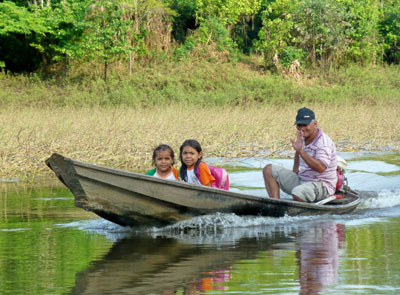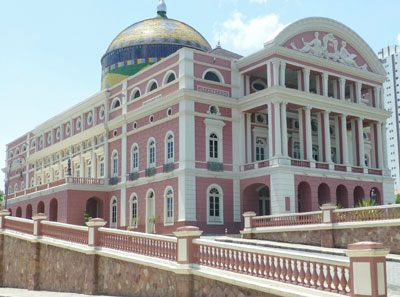Manaus, the Amazon and Rio
This item appears on page 54 of the April 2015 issue.
(3rd of 3 parts on Brazil)
It was a flight from Salvador to Brasilia, connecting with a flight northwest to the Amazon and Manaus, that started the final part of my September 2014, partially hosted, small-group journey through Brazil with longtime ITN advertiser ElderTreks.
Manaus is the capital and largest city (pop., two million) in the state of Amazonas. Founded in 1669 as a fort on the banks of the Rio Negro, 6 kilometers from its convergence with the mighty Amazon, the settlement achieved town status in 1832 when it was named Manaus, an altered spelling of “Manaos,” the name of the indigenous people living in the region.
It experienced rapid growth and fame in the late 19th century as the center of Brazil’s rubber boom. Funded by a cadre of wealthy rubber barons, the city became well known as an outpost of European civilization deep in the wilds of northern South America.
Among its striking features were the large mansions of the rubber barons and a majestic opera house bordered by broad, Parisian-style avenues and an expansive Italian piazza featuring impressive fountains.
Overall, much of the city these days appears more than a bit tired compared with its appearance during its glory days.
Upriver outing
On our first morning based in Manaus, we traveled up the Amazon in a small boat to visit the small, 5-family Tatuyo tribal village. In a large, traditional wood hut with a thatched roof, we enjoyed a 20-minute dance performance, part of a much longer ritual.
The dancers wore face paint and authentic Indian costume, including feather headdresses, and were accompanied by music played on wooden flutes and drums. The experience provided a glimpse of village life along the Amazon in times past.
We then sped across a broad expanse of water upriver to a floating platform, hoping to encounter the Amazon’s famed pink dolphins. Immediately upon entering the water, one other group member and I were gently nudged by and briefly saw two small dolphins. Unfortunately, those were the only dolphins we were destined to see that day.
Touring Manaus
The next day, our guided tour of Manaus included the riverfront central market, where we discovered a mind-boggling array of herbal products derived from plants, many found only in the Amazon region. A holistic approach to both preventative health maintenance and healing are refreshingly alive in this corner of the planet.
The nearby fish market displayed a remarkable variety and volume of river bounty.
At the adjacent docks, we viewed scores of various styles and sizes of ferries, which serve as the only transportation between Manaus and towns and villages near and far, both upriver and down. We also surveyed extensive and inspiring residential redevelopment projects that have replaced slums and that include an expansive system of recreational parkland.
When we finally had our long-awaited tour of the famous, highly ornate Manaus Opera House, we were in for an unexpected treat. We knew there were no performances scheduled during our brief stay in Manaus, but, by chance, we were privileged to sit in on a rehearsal of the Manaus Symphony Orchestra. To be entranced by “Tosca” in this remote, world-class opera house setting was a pure “Wow!”
The Amazon beckons
Departing Manaus aboard our cozy, 10-cabin riverboat, the Delphina, I was happy to again be departing the city, preferring to meld into the more relaxed life along the river.
Both departing and on our return, we enjoyed great views of the Manaus skyline and waterfront, including the inviting sandy swimming beaches with high-rise condo backdrops, similar in appearance to parts of coastal Florida but with one significant difference: Manaus is nearly 2,000 kilometers upriver from the Atlantic.
We had embarked on a 3-day, 2-night Amazon itinerary that focused on the region’s wildlife and on the people living along the river and its tributaries.
Our explorations included many small boat excursions into the backwaters, visiting villages and a school, walking in the dense jungle/forest, fishing for piranha and viewing wildlife at night.
For the fishing expedition we divided into two boats; our die-hard group landed about 50 piranhas. The cook on the Delphina turned some of the catch into a favorite local dish, piranha soup.
I’d happily return for more of the Amazon anytime.
On to Rio de Janeiro
Glittering Rio de Janeiro was the final stop on our action-packed 3-week journey, and my primary goal was to try to get a true feel for the life of the locals.
During our stay we navigated the huge, festive crowds viewing Rio from the spectacular heights of Sugar Loaf Mountain (395 meters high) and Corcovado (710 meters).
Atop Corcovado, visitors are rewarded with up-close views of the massive statue of Christ the Redeemer, which, if my experience is an indicator, may be the number-one selfie destination on the planet. At both mountaintop locations, the sweeping views over greater Rio were truly rave-worthy. Sugar Loaf seemed to provide the best overall photo ops.
City exploring
During an informative walking tour of historic Rio, our guide revealed the history of the longtime former Brazilian capital. Our stops included the Confeitaria Colombo, a popular Portuguese bakery and Rio institution built in 1894; the beautiful, late-19th-century Teatro Municipal; the hilly cobblestone lanes of Santa Teresa, and the photogenic Escadaria Selarón steps, featuring an amazing array of tiles from around the world.
Lastly, we visited Project Morrinho, a social and cultural undertaking located in the Pereira da Silva favela (slum) on a hillside overlooking the city.
While assisting in the building of Project Morrinho’s colorful small-scale community housing models provides some hands-on activity for local children, I found this particular favela experience to be far more revealing than inspiring. Being in a favela community that is clearly under the direct control of local drug lords can have that effect.
The Rio beaches
Since we were based only a short stroll away from the famous Copacabana and Ipanema beaches, I managed quick dips at both and some sun time on Copacabana during a free morning on our final day.
The beach fitness culture was particularly interesting to observe — scores of locals engaging in many types of physical fitness activities much like what takes place at both South Beach (Miami Beach) and Manhattan Beach (Los Angeles County) but with a uniquely Brazilian flair.
While I was careful regarding beach security, based on many pre-trip advisories, these two long, beautiful beaches seemed relatively safe, owing, no doubt in part, to the increased police presence in tourism areas leading up to the 2016 Rio Olympics.
FYI, there really was a “girl from Ipanema,” who a half century ago, at age 19, unintentionally inspired two Brazilian songwriters. Heloísa Pinheiro really was tall and tan and lovely, and today, at 69 years young, the still-popular former model and actress remains tall, tan and lovely.
Summing up Brazil
While space limitations prohibit detail, hopefully my 3-part series has provided some insight regarding the diverse amalgamation of peoples, mores, history and natural world features that define Brazil.
For travelers who desire a comprehensive experience of Brazil, I can strongly recommend ElderTreks’ 20-day small-group tour (maximum, 16 participants) upon which this article is based.
I must also commend our outstanding tour director, Gafa Stamato, who seamlessly guided us on our journey, including navigating the inevitable behind-the-scenes hiccups that accompany a complex itinerary in this part of the world.
The next Brazil tour operates Sept. 20-Oct. 9, 2016. The land-only cost is $8,195 per person, double occupancy, and includes all meals. Round-trip international flights from most North American gateway cities range from $1,300 to $1,550, and the tour’s seven domestic flights in Brazil total about $1,600. Lunches and dinners most days are in interesting restaurants featuring regional fare.
For information on the Brazil tour and small-group adventure-oriented journeys around the world, contact ElderTreks (597 Markham St., Toronto, ON, M6G 2L7, Canada; 800/741-7956, www.eldertreks.com).
Contact Randy care of ITN.





